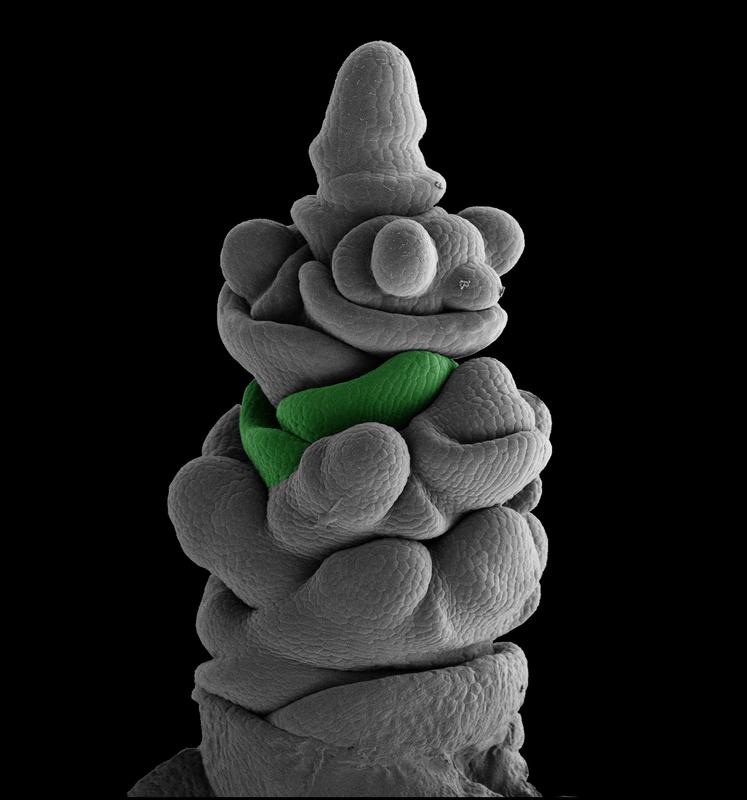Evolution of cereal spikes

Early stage of development of the spike in an ‘intermedium-m (int-m)’ mutant in barley. The green colour shows the meristem of the glume, which surrounds a terminal floret.
HHU / Jinshun Zhong
A research team led by Prof. Dr. Maria von Korff Schmising from Heinrich Heine University Düsseldorf (HHU) and the Max Planck Institute for Plant Breeding Research (MPIPZ) in Cologne investigated the genetic regulation of spike development in barley and wheat. As reported in the current issue of the Proceedings of the National Academy of Sciences of the United States of America (PNAS), they discovered different barley mutants with wheat-like spikes.
In plants, the ‘meristem’ refers to a type of tissue comprising undifferentiated cells from which various other plant organs can develop through cell division and differentiation. These ‘plant stem cells’ give rise to shoots, leaves and roots, but also spikes and flowers.
The research team including members of the Cluster of Excellence on Plant Sciences CEPLAS investigated the function of a gene responsible for the different spike forms of wheat and barley. This gene controls the activity of the spike and floret meristems and thus the number of spikelet and kernels per spike.
The closely related cool-season cereals, barley and wheat, produce variable and defined number of spikelets on their spikes, respectively. It is from these spikelets, that florets and the grains develop. The plant researchers have identified two barley mutants named ‘intermedium-m’ and ‘double seed 1’, which form a wheat-like spike with a terminal floret that consumes the spike meristem thereby reducing the number of lateral spikelets per spike. The INT-M/DUB1 gene maintains meristem identity and suppresses meristem differentiation. The ability of spike meristem to form lateral spikelets thus remains intact.
Prof. Dr. Maria von Korff Schmising, Head of the HHU Institute for Plant Genetics, about possible applications of the research findings: “These key regulators can be used to extend meristem activities. This may allow barley, wheat and other cereals to be modified to produce a higher grain yield.”
Originalpublikation:
Jinshun Zhong, G. Wilma van Esse, Xiaojing Bi, Tianyu LAN, Agatha Walla, Qing Sang, Rainer Franzen, and Maria von Korff, INTERMEDIUM-M encodes an HvAP2L-H5 ortholog and is required for inflorescence determinacy and spikelet determinacy in barley, PNAS 2021 Vol. 118
DOI: 10.1073/pnas.2011779118
Plant research: publication in PNAS
Media Contact
All latest news from the category: Life Sciences and Chemistry
Articles and reports from the Life Sciences and chemistry area deal with applied and basic research into modern biology, chemistry and human medicine.
Valuable information can be found on a range of life sciences fields including bacteriology, biochemistry, bionics, bioinformatics, biophysics, biotechnology, genetics, geobotany, human biology, marine biology, microbiology, molecular biology, cellular biology, zoology, bioinorganic chemistry, microchemistry and environmental chemistry.
Newest articles

Innovative 3D printed scaffolds offer new hope for bone healing
Researchers at the Institute for Bioengineering of Catalonia have developed novel 3D printed PLA-CaP scaffolds that promote blood vessel formation, ensuring better healing and regeneration of bone tissue. Bone is…

The surprising role of gut infection in Alzheimer’s disease
ASU- and Banner Alzheimer’s Institute-led study implicates link between a common virus and the disease, which travels from the gut to the brain and may be a target for antiviral…

Molecular gardening: New enzymes discovered for protein modification pruning
How deubiquitinases USP53 and USP54 cleave long polyubiquitin chains and how the former is linked to liver disease in children. Deubiquitinases (DUBs) are enzymes used by cells to trim protein…



